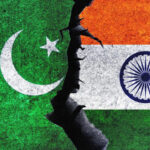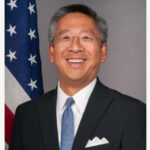After the initial uncertainty, relations with India picked up steam under Trump
President Donald Trump has ended his first term in office with a big push for ties with India, sending his Secretary of State Mike Pompeo for talks just one week before the election, and holding two rallies with Prime Minister Narendra Modi, in Houston and in Ahmedabad, in the past year.
Four years ago, however, the victory of Mr. Trump in the U.S. Presidential elections had struck a sense of foreboding for officials in the Modi government. India’s newly appointed Ambassador to Washington Navtej Sarna landed in the U.S. capital just three days before the election results, at a time the expectation was that Hillary Clinton, who was well-known to the Indian establishment, had worked closely with New Delhi as Secretary of State, would enter the White House. It was no secret that India’s top diplomats had to knock on many doors, enlist the help of prominent Indian-Americans, as well as businessmen in order to reach out to Team Trump.
Within a few months, Mr. Trump delivered a few blows to India’s expectations from the U.S., including a decision on visa restrictions, a hard-hitting speech on India as the “tariff king”, and clubbing India and China both on trade and on receiving an unfair advantage on climate change, which he said was one of the reasons the U.S. was walking out of the Paris climate accord that his predecessor, Barack Obama had ratified just months earlier. However, the invitation to PM Modi to the White House in June 2017 turned things around, and Mr. Trump’s South Asia policy, and the U.S.’s decision to revive the Quad and rename its Pacific Command as the ‘Indo-Pacific’ Command set into motion a more positive foreign policy framework for India.
“Over just three or four months in 2018, we saw the Strategic Trade Authorisation (STA)- 1 categorisation for India; the first 2+2 dialogue; the signing of the COMCASA in a shape acceptable to us; the approval by Congress for a general waiver provision in the CAATSA; a (temporary) waiver for India on Iran oil purchases and Chabahar… A very impressive list of strategic gains,” Mr. Sarna recounted to The Hindu.
China and Pakistan
More importantly, given the 2017 Doklam conflict with China and continuing cross-border attacks by groups from Pakistan, Mr. Trump’s policy towards both India’s biggest headaches became the U.S.’s most important foreign policy shift. One big marker was when on January 1, 2018, Mr. Trump tweeted that the U.S. would end aid to Pakistan that had given the U.S. “nothing but lies and deceit” and “safe haven to terrorists”.
Subsequently, the U.S. suspended its military assistance payments, military sales and led the way on Pakistan’s grey-listing at the Financial Action Task Force (FATF) to designate more terrorists at the UN Security Council, including those that targeted India. On China too, after two years of reaching out to Xi Jinping, Mr. Trump made a turnaround, and the U.S. offered India moral and military support to counter Chinese aggression, led its own attack on China’s Belt and Road Initiative and its 5G telecom push and vowed (not yet realised) a counter to China’s loans to countries in the Indo-Pacific region.
Regardless of the positives, several Trump decisions have come as a shock to the Modi government. His decision to forge talks with the Taliban, in concert with concessions to Pakistan in Afghanistan, has run counter to his administration’s other promises. Just a day after Mr. Modi swore in his new Cabinet last year, Mr. Trump announced he would withdraw India’s Generalized System of Preferences (GSP) status for exporters.
“The U.S. has treated India far more gently than Mr. Trump has treated China, or even U.S. allies, and despite several opportunities to train his guns on India, other than the removal of the GSP, he didn’t do very much on penalising India,” said noted analyst Ashley Tellis at a seminar organised by Carnegie India this week.
Unpredictable attacks
The biggest challenge, say officials, is the unpredictability that has accompanied Mr. Trump, particularly in his tweets, where he had relayed private conversations with PM Modi publicly. These include his mimicry of Mr. Modi’s accent when he suggested the Prime Minister made an offer to reduce Harley Davidson tariffs; details of a conversation he said he had with Mr. Modi over China’s transgressions at the LAC this year (which the MEA curtly denied); a crudely worded threat from Mr. Trump over India’s ban on exports of the drug HCQ; and even Mr. Trump’s bizarre claim last year that Mr. Modi asked him to “mediate” between Pakistan and India on Kashmir.
On each occasion, the government has chosen to side-step the verbal “landmines” Mr. Trump delivered, in favour of a more stable bilateral relationship. Where that has paid off the most is in Mr. Trump’s reciprocal restraint while commenting on India’s internal affairs, and unlike many other countries, and leaders in the American opposition party, Mr. Trump has not raised objections to the Modi government’s decision on Article 370, the arrest of leaders and telecom ban in Kashmir, or on the Citizenship Amendment Act (CAA). Even when Mr. Trump landed in Delhi amidst some of the worst communal violence the city has seen in decades, he carefully avoided any mention of it.
When asked what a second Trump administration will mean for India, many diplomats say it will probably be “more of the same, only more unpredictable”. “A victorious second term Trump will have no stakes in the system. We will have to put on seatbelts, speed on the straights and hold on at the curves. India will have to roll with the punches on immigration and racialism, take the sting out of the trade issues by being a step ahead. It will also mean navigating for advantage in a divided world, with the U.S. ceding space — a world where multilateralism will be without U.S. leadership,” said Mr. Sarna.
More ups than downs, and many surprise turns in Trump’s foreign policy for India
After the initial uncertainty, relations with India picked up steam under Trump
President Donald Trump has ended his first term in office with a big push for ties with India, sending his Secretary of State Mike Pompeo for talks just one week before the election, and holding two rallies with Prime Minister Narendra Modi, in Houston and in Ahmedabad, in the past year.
Four years ago, however, the victory of Mr. Trump in the U.S. Presidential elections had struck a sense of foreboding for officials in the Modi government. India’s newly appointed Ambassador to Washington Navtej Sarna landed in the U.S. capital just three days before the election results, at a time the expectation was that Hillary Clinton, who was well-known to the Indian establishment, had worked closely with New Delhi as Secretary of State, would enter the White House. It was no secret that India’s top diplomats had to knock on many doors, enlist the help of prominent Indian-Americans, as well as businessmen in order to reach out to Team Trump.
Within a few months, Mr. Trump delivered a few blows to India’s expectations from the U.S., including a decision on visa restrictions, a hard-hitting speech on India as the “tariff king”, and clubbing India and China both on trade and on receiving an unfair advantage on climate change, which he said was one of the reasons the U.S. was walking out of the Paris climate accord that his predecessor, Barack Obama had ratified just months earlier. However, the invitation to PM Modi to the White House in June 2017 turned things around, and Mr. Trump’s South Asia policy, and the U.S.’s decision to revive the Quad and rename its Pacific Command as the ‘Indo-Pacific’ Command set into motion a more positive foreign policy framework for India.
“Over just three or four months in 2018, we saw the Strategic Trade Authorisation (STA)- 1 categorisation for India; the first 2+2 dialogue; the signing of the COMCASA in a shape acceptable to us; the approval by Congress for a general waiver provision in the CAATSA; a (temporary) waiver for India on Iran oil purchases and Chabahar… A very impressive list of strategic gains,” Mr. Sarna recounted to The Hindu.
China and Pakistan
More importantly, given the 2017 Doklam conflict with China and continuing cross-border attacks by groups from Pakistan, Mr. Trump’s policy towards both India’s biggest headaches became the U.S.’s most important foreign policy shift. One big marker was when on January 1, 2018, Mr. Trump tweeted that the U.S. would end aid to Pakistan that had given the U.S. “nothing but lies and deceit” and “safe haven to terrorists”.
Subsequently, the U.S. suspended its military assistance payments, military sales and led the way on Pakistan’s grey-listing at the Financial Action Task Force (FATF) to designate more terrorists at the UN Security Council, including those that targeted India. On China too, after two years of reaching out to Xi Jinping, Mr. Trump made a turnaround, and the U.S. offered India moral and military support to counter Chinese aggression, led its own attack on China’s Belt and Road Initiative and its 5G telecom push and vowed (not yet realised) a counter to China’s loans to countries in the Indo-Pacific region.
Regardless of the positives, several Trump decisions have come as a shock to the Modi government. His decision to forge talks with the Taliban, in concert with concessions to Pakistan in Afghanistan, has run counter to his administration’s other promises. Just a day after Mr. Modi swore in his new Cabinet last year, Mr. Trump announced he would withdraw India’s Generalized System of Preferences (GSP) status for exporters.
“The U.S. has treated India far more gently than Mr. Trump has treated China, or even U.S. allies, and despite several opportunities to train his guns on India, other than the removal of the GSP, he didn’t do very much on penalising India,” said noted analyst Ashley Tellis at a seminar organised by Carnegie India this week.
Unpredictable attacks
The biggest challenge, say officials, is the unpredictability that has accompanied Mr. Trump, particularly in his tweets, where he had relayed private conversations with PM Modi publicly. These include his mimicry of Mr. Modi’s accent when he suggested the Prime Minister made an offer to reduce Harley Davidson tariffs; details of a conversation he said he had with Mr. Modi over China’s transgressions at the LAC this year (which the MEA curtly denied); a crudely worded threat from Mr. Trump over India’s ban on exports of the drug HCQ; and even Mr. Trump’s bizarre claim last year that Mr. Modi asked him to “mediate” between Pakistan and India on Kashmir.
On each occasion, the government has chosen to side-step the verbal “landmines” Mr. Trump delivered, in favour of a more stable bilateral relationship. Where that has paid off the most is in Mr. Trump’s reciprocal restraint while commenting on India’s internal affairs, and unlike many other countries, and leaders in the American opposition party, Mr. Trump has not raised objections to the Modi government’s decision on Article 370, the arrest of leaders and telecom ban in Kashmir, or on the Citizenship Amendment Act (CAA). Even when Mr. Trump landed in Delhi amidst some of the worst communal violence the city has seen in decades, he carefully avoided any mention of it.
When asked what a second Trump administration will mean for India, many diplomats say it will probably be “more of the same, only more unpredictable”. “A victorious second term Trump will have no stakes in the system. We will have to put on seatbelts, speed on the straights and hold on at the curves. India will have to roll with the punches on immigration and racialism, take the sting out of the trade issues by being a step ahead. It will also mean navigating for advantage in a divided world, with the U.S. ceding space — a world where multilateralism will be without U.S. leadership,” said Mr. Sarna.






NO COMMENT